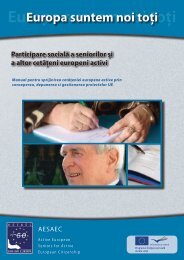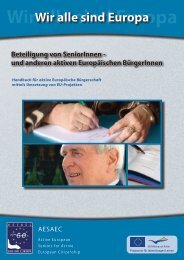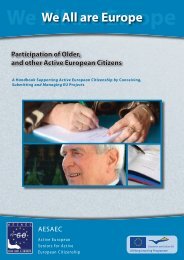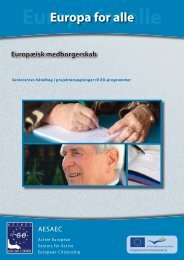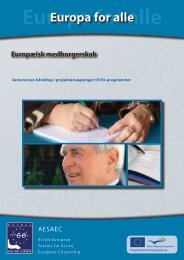We All are Europe - AESAEC
We All are Europe - AESAEC
We All are Europe - AESAEC
You also want an ePaper? Increase the reach of your titles
YUMPU automatically turns print PDFs into web optimized ePapers that Google loves.
Module 1 – The <strong>Europe</strong>an Union and its Relevance for Senior Citizens<br />
Treaty of Rome (1957) establishing the <strong>Europe</strong>an Economic Community (EEC).<br />
The main aim of this treaty was the creation of a common market between<br />
the member states. It introduced the free flow of capital and<br />
workers between members.<br />
The Treaty of Maastricht (1992) was a major step in the development of the<br />
<strong>Europe</strong>an Community. It created the <strong>Europe</strong>an Union and led to the creation of the Euro. The<br />
treaty created what is commonly referred to as the pillar structure of the <strong>Europe</strong>an Union.<br />
This concept of the Union divides it into the <strong>Europe</strong>an Community (EC) pillar, the Common<br />
Foreign and Security Policy (CFSP) pillar, and the Justice and Home Affairs (JHA) pillar. The<br />
latter two pillars <strong>are</strong> intergovernmental policy <strong>are</strong>as, whereby the greater power lies with the<br />
member states, whilst with the <strong>Europe</strong>an Community pillar the Union's supranational<br />
institutions — the <strong>Europe</strong>an Commission, the <strong>Europe</strong>an Parliament and the <strong>Europe</strong>an Court of<br />
Justice — hold most of the power. <strong>All</strong> three pillars combined together <strong>are</strong> called the <strong>Europe</strong>an<br />
Union.<br />
The Treaty of Amsterdam (1997) meant a greater emphasis on citizenship and the rights of<br />
individuals. It sought to achieve more democracy in the shape of increased powers for the<br />
<strong>Europe</strong>an Parliament, a new approach to issues of employment, a more integrated community<br />
in terms of freedom of movement, security and justice, the beginnings of a cohesive<br />
Common Foreign and Security Policy (CFSP) and the reform of EU institutions in the run up to<br />
enlargement.<br />
The Treaty of Nice (2001) reformed the institutional structure of the <strong>Europe</strong>an Union to withstand<br />
eastward expansion. The Amsterdam Treaty was originally intended to have tackled this aim;<br />
however it failed to do so at that time. There was doubt for a time whether the treaty would<br />
be brought into force after its initial rejection by Irish voters in a June 2001 referendum. This<br />
referendum result was reversed in a subsequent referendum held a little over a year later.<br />
The Draft Constitutional Treaty (Rome 2004) was intended to establish a Constitution for <strong>Europe</strong><br />
and was signed by 53 senior political figures from the 25 EU member states. In most cases<br />
heads of state designated plenipotentiaries to sign the treaty, however some presidents also<br />
signed on behalf of countries which hold the status of a republic.<br />
The Reform Treaty of Lisbon (2007). Changes included more qualified majority voting in the Council<br />
of Ministers, increased involvement of the <strong>Europe</strong>an Parliament in the legislative process<br />
through extended co-decision making with the Council of Ministers, eliminating the pillar<br />
system and the creation of a President of the <strong>Europe</strong>an Council with a term of office of two<br />
and half years and a High Representative for Foreign Affairs to present a united position on<br />
EU policies. If ratified, the Treaty of Lisbon would also make the Union's human rights<br />
charter, the Charter of Fundamental Rights, legally binding. 3<br />
The Lisbon Strategy is, apart from the treaties, also a highly important concept in connection with<br />
the objectives and aims of the <strong>AESAEC</strong> training course. Due to its importance it needs to be<br />
considered by senior citizens, when preparing a <strong>Europe</strong>an project proposal. The strategy was<br />
set out by the <strong>Europe</strong>an Council in Lisbon in 2000 and is also known as the Lisbon Agenda or<br />
Lisbon Process. It is an action and development plan for the EU, important for all social<br />
groups, older citizens included. Its aim is to make the EU "the most dynamic and competitive<br />
knowledge-based economy in the world by 2010, capable of sustainable economic growth with<br />
more and better jobs and greater social cohesion, and with respect for the environment".<br />
Now, one year away from 2010, we know that this plan was much too ambitious to be fully<br />
implemented successfully. However, it has produced some success and good results in the<br />
fields of education and lifelong learning, in the general development of EU citizenship, in<br />
economic growth and in job creation within the EU. In respect of the four pillars of the Lisbon<br />
Strategy, the focus is now as follows:<br />
• member states should strive to adopt measures to promote creativity and enterprise with<br />
a view to making <strong>Europe</strong> the most creative environment in the world<br />
3 During the development of this course book (November 2009), the Czech Republic, as the last of the 27 EU member states,<br />
signed the Reform Treaty of Lisbon, which means the treaty will now come into force.<br />
35




